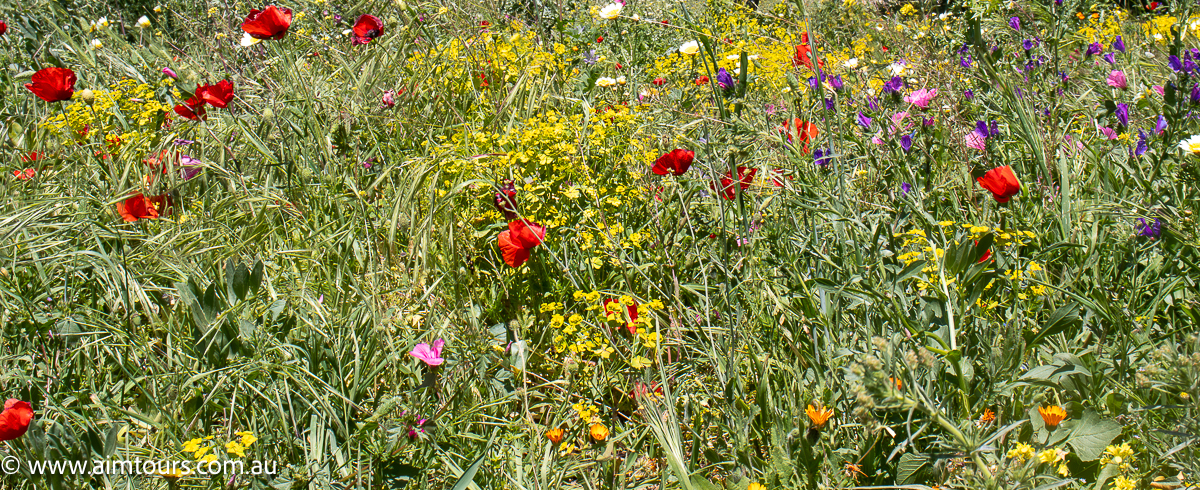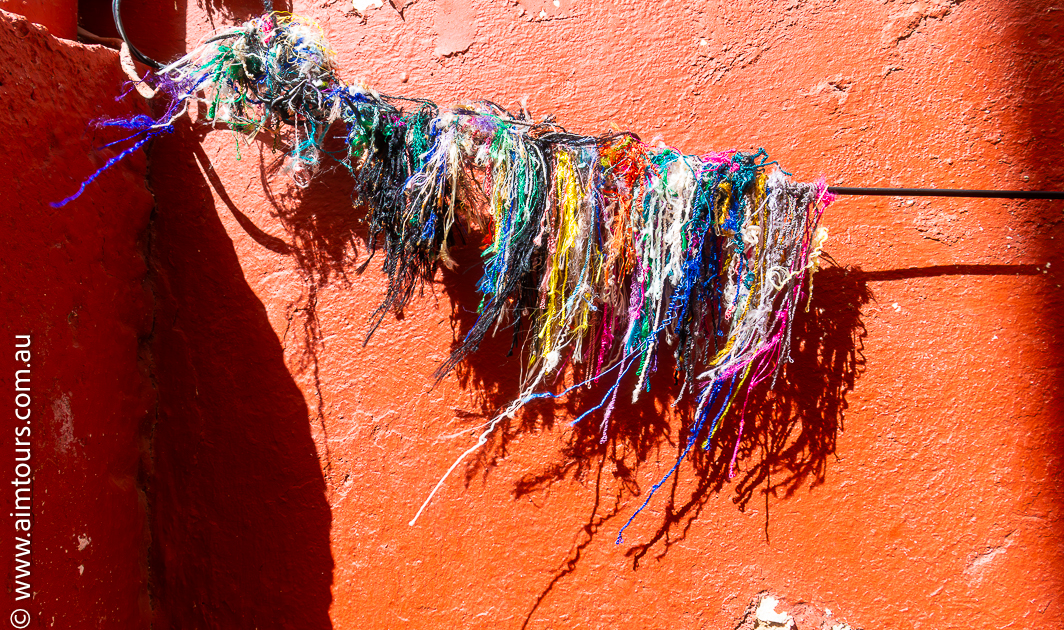A few days’ of reflection in
Morocco’s holiest city – Moulay Idriss Zerhoun
Cara Ghassemian
Copyright AIMTours 2024
(New photos added 22 June 2024)

Moulay Idriss Zerhoune in the distance
Aziz my driver and I arrived from Casablanca, in Moulay Idriss Zerhoun, the most holy city in Morocco, after dark.
We woke the next morning in our wholly female-owned-and-managed dar to glorious spring sunshine. It was windy as is usual at that time of year – facilitating pollination of the surrounding canopy of spring wildflowers and a Shakespearean symbol of cleansing and rebirth.
We sat on the terrace and ate our first Moroccan breakfast of our latest adventure together, including fresh bread and, unusually for Morocco, raisins.
Moulay Idriss arrived from Saudi Arabia in about 789 AD, to spread the word of the Prophet Mohammed to the local Berber population. He started a family with a local woman, and was to become the ruler of Morocco’s first Islamic Idrisid Dynasty. He is now interred here and his grand mausoleum dominates the city. It is only accessible to Moslems, many of whom have made their pilgrimage to this place over the centuries, from all over the world.
For many years, non-Moslems were not permitted to visit this holiest of cities at all, and then later, only during daylight hours.
Today, Moulay Idriss Zerhoun remains a strikingly non-touristic city with a prevailing religiosity – like Chefchaouen, but without the tourist crowds or the made-in-China souvenirs or other trinkets.
For Aziz and I, the “first station of the crescent” on our pilgrimage here was the Roman bath, now dry, on the outskirts of the city. Standing adjacent to it is a staturesque Australian gum tree that drew my eyes up to the sky and seemed to me to be symbolic or mystically meaningful in some way.

The Roman Bath at Moulay Idriss Zerhoun with the adjacent gum tree. Locals used to take a dip in it, but it has now been dry for some years.
There were loads of wildflowers everywhere. I surveyed and photographed fields of them, as the Call to Prayer vibrated across the scene from the minaret of a nearby – but unseen – mosque. During this, I felt that momentary release from the melancholic state of spiritual homesickness and a quietening (however fleeting) of existential angst, that I always do, during the Adhan. The beauty of the fields of spring flowers, this day, added to the intensity of that feeling.

Glorious spring wildflowers around Moulay Idriss Zerhoun. It really was such a lovely day and April is a great time for our colour saturation tour in 2026.
Both Islam and nature are symbolised by the colour of green, and green is ubiquitous in the clothes and decorative elements of Moroccan architecture and interior design.
That night, Aziz and I returned to our dar for dinner on the terrace and enjoyed a spectacular Royal purple sunset. Later, Aziz took a prayer rug from somewhere and kneeling on it he faced Mecca and said his prayers for the fifth and final time that day, as is his daily practice.

One of the many green water fountains at Moulay Idriss.
Aziz is a Cherif, that is to say, a descendant of the Prophet Mohammed and traditionally said to be the holder of significant baraka (“blessing” or “divine favour”) by virtue of his lineage. He is related to Moulay Ali Cherif – first sultan of the current Alouite Dynasty – whose mausoleum is at Rissani. Unusually for the time, Aziz’s Arab father, a Caid or Chief in Arabic, married his Berber mother who also unusually for the time, was educated too. Wow, an intermarriage rather like Moulay Idriss’s own I realise just now (an observation that would no doubt amuse Aziz). Although Aziz is what some may refer to as a humble driver, I can also say that the care and concern, the respect and discipline that he displays in his job, from that you can tell he is the son of a Caid. I told him so, too.
The next day, we travelled to Bhalil, locale of 500 cave homes. The ladies of Bhalil are also well known for sitting outside their homes sewing little knotted djellaba (this is a long, hooded robe) buttons, and placing them in flat reed baskets nearby.

Ladies sewing their djellaba buttons at Bhalil. This image has many interesting aspects.

These are some threads that you will see hanging all over the old part of town, that are remnants of threads used by the ladies as they make their djellaba buttons. So charming.
We visited Latifa who made us a fragrant orange-bud and mint tea. With that she served us a traditional, sweet dessert made of crushed nuts, flour, honey and a little oil; eaten with a spoon. She also had her large flat basket with many buttons – it was a centrepiece on a small table in her beautiful little cave-nest. It occurred to me that the baskets containing the knot-buttons were also like nests – of miniature eggs. The feeling of this place, as a source or water-fountain of life, was underlined by the numerous images of storks everywhere on building facades, and the prolific number of children and kittens.

One of the many images of storks at Bhalil in the oldest part of town.
Even so, I would say that overall the white streets were unusually quiet and still. It was a Sunday.

A small, nearly deserted square at Bhalil. Like a Chirico painting.
When we later walked through the old gate, leaving the cave homes behind that afternoon, it really seemed as though I had passed my day in another time zone – in the old Morocco where there was community, artisanal creativity, care and fecundity. Life.

This image has beautiful angles and composition. The ladies of Bhalil wear the white chador unlike in the south where the Arab women wear black chadors and the Amazigh women wear black chadors too, but embroidered with lovely colours.
The following day was a quiet one back in Moulay Idriss.
The next “station of the crescent” that Aziz and I visited on our pilgrimage to this area was the famous Scorpion House to partake of a Moroccan-style lunch with an Andalusian feel. The home was impeccably decorated with Moroccan artefacts, owned by the English proprietor of the famous Cafe Clock at Fez – and now also in Chefchaouen and Marrakech – where entertainment includes traditional music, dance and storytelling.

At the portal of Scorpion House
A lot of the highest end tours lunch at Scorpion House. I didn’t feel comfortable for some reason. The glare on the balcony bouncing off the white-washed walls into my eyes was pitiless and agitating, for one thing. I did however warm to the manager at Scorpion House.
Hamza, whose family has been in Moulay Idriss for many generations, seemed to have such a big heart. Who can say what pilgrim’s DNA he may have inherited as his dark blond hair and green eyes are rare for a Moroccan. In fact, I heard somewhere that green is the rarest eye colour world-wide. I was feeling again the presence of something mystic. On this occasion it was in the fact of Hamza’s eyes being so mesmerizingly green, coupled with the overt generosity of spirit that he was radiating that afternoon.
After lunch, in response to my request, Hamza took us to see the inside of an uninhabited, centuries-old home in the medina. I found it fascinating. We had to bow our heads to enter the portal – that was intentional apparently, to make visitors convey respect to the occupants. It was a hodgepodge of mosaics. There were three levels of salons that were converted into sleeping quarters at night, as remains the custom to this day in Moroccan homes. The terrace was also in a state of disrepair. Its main use (I am told) is for the inhabitants to sleep there under the stars on hot nights, and also to keep and slaughter the lamb for Eid el Adha, an annual Moslem festival that honours the prophet Ibrahim’s willingness to sacrifice his own son as an act of obedience to God’s will.
Next day, Aziz and I walked around the city itself (including its main square) and we saw maybe three other western tourists, maximum.

This was at the local souk at Moulay Idriss Zerhoun. Can you believe the beautiful chaos of line and colour, reminiscent of an abstract painting?
In the afternoon we were taken on a guided walk of the surrounding nature by Ahmed. We walked alongside the border of a cemetery, all the way down a hill that was dotted with grave headstones. Locals passed us in the opposite direction. They were ascending the hill, while seemingly burdened with large flagons of water from the source at the base of the incline. Yet at the same time, they were mustering hopeful smiles as they greeted us.

Still more green. Cara on her walk through the nature surrounding Moulay Idriss one afternoon.
I say “source” for a body of water, because that is what Aziz always called water in natural settings, just as the Prophet Moulay Idriss was a source of the “water of eternal life”, being the wisdom of the Prophet Mohammed. Indeed, we talked about Moulay going for walks through the same countryside and mused as to its additional wildness or sauvergery in his time.
Later on, as we navigated a bend in our path-destiny, we suddenly came upon a tortoise crossing it ever so slowly. We stopped to take a few photos of him. Perhaps sidi (my lord) tortoise was on his own pilgrimage, edging oh so slowly to the source.

Cara respectfully holding Sidi Tortoise
There was, however, one disappointing aspect of our day’s excursion. We saw so much distracting evidence of polluting consumerism along the way. I didn’t see how this befitted at all the surroundings of a holy city of Islam, one of the tenets of which is that ascetic cleanliness is part of godliness.
I was also struck by the fact that, the many children we saw along the way had such an old-style way of playing. No internet. Just playing a game of cards together on old steps or frolicking in ancient freshwater pools, alongside tiny kittens who came out tentatively from the bushes to greet (with faint meows) new visitors to their turf. There was a quality of heavenly Paradise to it all.
That night we slept well – the exertion had been exhausting.
Next day, we packed up our belongings and left Moulay Idriss Zerhoun for Fez – the construction of which Moulay Idriss had also initiated before his son completed it – to stay at a riad inspired by the medieval Sufi poem, “The Conference of the Birds”, an allegory of a soul’s journey to find self. In Fez we met up with the clients who would begin our Magic and Mysticism tour the next day. We were scheduled to return to Moulay Idriss Zerhoun in the next few days, because these clients would be visiting the former Roman settlement of Volubilis by donkey from Moulay Idriss. The dar where Aziz and I had stayed pays for vet care for local donkeys, that often receive a very rough time in Morocco.

On the way to Volubilis astride a “Berber taxi” as one local who passed by, said. Men in coffee shops raised their tea glasses in salute, smiled and waved as we went past.
If you’d like to experience any of the things we mention here as part of a tour with us, please contact us on holidays@aussiesinmoroccotours.com.au
Published May 2024
